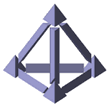
 |
The World Wide Web Consortium (W3C) develops technologies (specifications, guidelines, software, and tools) to promote the evolution of the Web and ensure its interoperability.
A W3C Recommendation (e.g. XML, XML Schema) is a technical report that is the end result of a consensus inside and outside of W3C about a particular technology or policy. It can also be thought of as a Web Standard. Before a technology becomes a W3C Recommendation it must follow a number of stages, known as the W3C Recommendation Track. During the earlier stages of the W3C Recommendation Track a technology or policy is subject to change.
XML
The Extensible Markup Language (XML) is the universal format for structured documents and data on the Web.
An XML document is extensible and self describing and can exist on its own without any further definition of its structure. Alternatively a Document Type Definition (DTD) can be used to define the XML document's structure with a list of legal elements. A DTD can then be used to check if an XML document is valid (has all its elements in the right place) and can also be used as a contract for exchanging data with another party.
In addition to being a data format, XML also refers to a wide range of associated technologies. W3Schools provides an overview of the main XML technologies and further links can be found at the W3C web site.
Main sites and specifications
Extensible Markup Language (XML) 1.0 - W3C Recommendation
http://www.w3.org/TR/REC-xml
Overviews and tutorials
| XML in 10 points | Explains the basic concepts of XML |
| W3Schools XML School | Learn what XML is, and the difference between XML and HTML. You can also try some examples and learn how to start using XML in your applications. |
| W3Schools DTD School | Learn what DTD is and how to use one to define the legal elements of an XML document. |
| W3Schools XML Namespaces | Learn about XML Namespaces, which provides a method to avoid XML element name conflicts. |
XML Schema
The XML Schema language is a new alternative format for describing XML structure, intended to allow more expressive data validation than DTD. XML Schema allows richer structural definitions including uniqueness constraints and references between elements, and supports data types (e.g. string, integer, double, date) and namespaces.
Main sites and specifications
The XML Schema Recommendation consists of 2 parts:
- XML
Schema Part 1: Structures - Facilities for describing the structure
and constraining the contents of XML documents
- XML Schema Part 2: Datatypes - Facilities for defining data types to be used in XML Schemas as well as other XML specifications.
Overviews and tutorials
| W3Schools XML Schema School | Learn what an XML Schema is, how XML Schema will replace DTD, and how to use the XML Schema language in your applications. |
| XML Schema Part 0 | Primer Intended to provide an easily readable description of the XML Schema facilities, and is oriented towards quickly understanding how to create schemas using the XML Schema language. |
SVG
Scalable Vector Graphics (SVG) is a language for describing two-dimensional graphics in XML. It allows three types of graphic objects - vector graphic shapes, images and text, which can be grouped, styled and transformed. The drawings are scalable (so you can zoom in or out without loss of detail) and can be interactive and dynamic. SVG became a W3C Recommendation in September 2001 and so it is not widely supported by the standard browsers yet. A free SVG viewer can be downloaded from the Adobe SVG Zone which also includes some demonstrations of SVG in action. A Java SVG plug-in designed for Linux can be downloaded from Batik SVG Toolkit. Other SVG related software can be found on the W3C SVG Overview page.
Main sites and specifications
Scalable Vector Graphics (SVG) 1.0 Specification - W3C Recommendation
defining the features and syntax for SVG.
http://www.w3.org/TR/SVG/
Overviews and tutorials
| SVG Executive Summary Scalable Vector Graphics (SVG) | An Executive Summary - Sun Microsystems. A brief introduction to SVG, followed by four examples of SVG graphics, and links to two code samples. |
| SVG-spot tutorials | Some basic SVG tutorials. |
| W3C Scalable Vector Graphics Overview | The official W3C overview of the Scalable Vector Graphics (SVG) format. |
School of Engineering Sciences, University of Southampton, Highfield, Southampton SO17 1BJ
Tel: +44 (0)2380 593116, Fax: +44 (0)2380 597082 Email: projectoffice@geodise.org
© The Geodise Project 2001-2004
